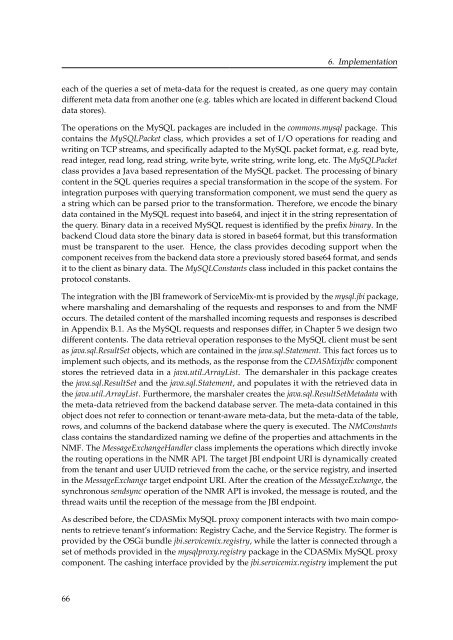Diploma Thesis Santiago Gómez Sáez - IAAS
Diploma Thesis Santiago Gómez Sáez - IAAS
Diploma Thesis Santiago Gómez Sáez - IAAS
You also want an ePaper? Increase the reach of your titles
YUMPU automatically turns print PDFs into web optimized ePapers that Google loves.
6. Implementation<br />
each of the queries a set of meta-data for the request is created, as one query may contain<br />
different meta data from another one (e.g. tables which are located in different backend Cloud<br />
data stores).<br />
The operations on the MySQL packages are included in the commons.mysql package. This<br />
contains the MySQLPacket class, which provides a set of I/O operations for reading and<br />
writing on TCP streams, and specifically adapted to the MySQL packet format, e.g. read byte,<br />
read integer, read long, read string, write byte, write string, write long, etc. The MySQLPacket<br />
class provides a Java based representation of the MySQL packet. The processing of binary<br />
content in the SQL queries requires a special transformation in the scope of the system. For<br />
integration purposes with querying transformation component, we must send the query as<br />
a string which can be parsed prior to the transformation. Therefore, we encode the binary<br />
data contained in the MySQL request into base64, and inject it in the string representation of<br />
the query. Binary data in a received MySQL request is identified by the prefix binary. In the<br />
backend Cloud data store the binary data is stored in base64 format, but this transformation<br />
must be transparent to the user. Hence, the class provides decoding support when the<br />
component receives from the backend data store a previously stored base64 format, and sends<br />
it to the client as binary data. The MySQLConstants class included in this packet contains the<br />
protocol constants.<br />
The integration with the JBI framework of ServiceMix-mt is provided by the mysql.jbi package,<br />
where marshaling and demarshaling of the requests and responses to and from the NMF<br />
occurs. The detailed content of the marshalled incoming requests and responses is described<br />
in Appendix B.1. As the MySQL requests and responses differ, in Chapter 5 we design two<br />
different contents. The data retrieval operation responses to the MySQL client must be sent<br />
as java.sql.ResultSet objects, which are contained in the java.sql.Statement. This fact forces us to<br />
implement such objects, and its methods, as the response from the CDASMixjdbc component<br />
stores the retrieved data in a java.util.ArrayList. The demarshaler in this package creates<br />
the java.sql.ResultSet and the java.sql.Statement, and populates it with the retrieved data in<br />
the java.util.ArrayList. Furthermore, the marshaler creates the java.sql.ResultSetMetadata with<br />
the meta-data retrieved from the backend database server. The meta-data contained in this<br />
object does not refer to connection or tenant-aware meta-data, but the meta-data of the table,<br />
rows, and columns of the backend database where the query is executed. The NMConstants<br />
class contains the standardized naming we define of the properties and attachments in the<br />
NMF. The MessageExchangeHandler class implements the operations which directly invoke<br />
the routing operations in the NMR API. The target JBI endpoint URI is dynamically created<br />
from the tenant and user UUID retrieved from the cache, or the service registry, and inserted<br />
in the MessageExchange target endpoint URI. After the creation of the MessageExchange, the<br />
synchronous sendsync operation of the NMR API is invoked, the message is routed, and the<br />
thread waits until the reception of the message from the JBI endpoint.<br />
As described before, the CDASMix MySQL proxy component interacts with two main components<br />
to retrieve tenant’s information: Registry Cache, and the Service Registry. The former is<br />
provided by the OSGi bundle jbi.servicemix.registry, while the latter is connected through a<br />
set of methods provided in the mysqlproxy.registry package in the CDASMix MySQL proxy<br />
component. The cashing interface provided by the jbi.servicemix.registry implement the put<br />
66

















